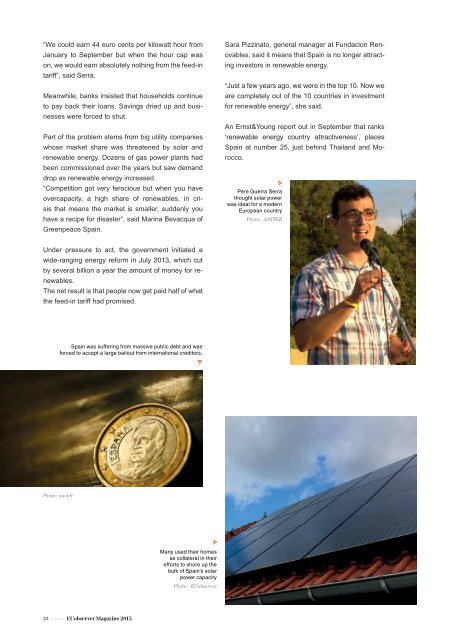Climate change: What are the regions doing?
The 2015 edition of EUobserver's Regions & Cities magazine focuses on climate change and what cities and regions are doing.
The 2015 edition of EUobserver's Regions & Cities magazine focuses on climate change and what cities and regions are doing.
Create successful ePaper yourself
Turn your PDF publications into a flip-book with our unique Google optimized e-Paper software.
“We could earn 44 euro cents per kilowatt hour from<br />
January to September but when <strong>the</strong> hour cap was<br />
on, we would earn absolutely nothing from <strong>the</strong> feed-in<br />
tariff”, said Serra.<br />
Meanwhile, banks insisted that households continue<br />
to pay back <strong>the</strong>ir loans. Savings dried up and businesses<br />
were forced to shut.<br />
Part of <strong>the</strong> problem stems from big utility companies<br />
whose market sh<strong>are</strong> was threatened by solar and<br />
renewable energy. Dozens of gas power plants had<br />
been commissioned over <strong>the</strong> years but saw demand<br />
drop as renewable energy increased.<br />
“Competition got very ferocious but when you have<br />
overcapacity, a high sh<strong>are</strong> of renewables, in crisis<br />
that means <strong>the</strong> market is smaller, suddenly you<br />
have a recipe for disaster”, said Marina Bevacqua of<br />
Greenpeace Spain.<br />
Sara Pizzinato, general manager at Fundacion Renovables,<br />
said it means that Spain is no longer attracting<br />
investors in renewable energy.<br />
“Just a few years ago, we were in <strong>the</strong> top 10. Now we<br />
<strong>are</strong> completely out of <strong>the</strong> 10 countries in investment<br />
for renewable energy”, she said.<br />
An Ernst&Young report out in September that ranks<br />
‘renewable energy country attractiveness’, places<br />
Spain at number 25, just behind Thailand and Morocco.<br />
Pere Guerra Serra<br />
thought solar power<br />
was ideal for a modern<br />
European country<br />
Photo: ANPIER<br />
Under pressure to act, <strong>the</strong> government initiated a<br />
wide-ranging energy reform in July 2013, which cut<br />
by several billion a year <strong>the</strong> amount of money for renewables.<br />
The net result is that people now get paid half of what<br />
<strong>the</strong> feed-in tariff had promised.<br />
Spain was suffering from massive public debt and was<br />
forced to accept a large bailout from international creditors.<br />
Photo: owly9<br />
Many used <strong>the</strong>ir homes<br />
as collateral in <strong>the</strong>ir<br />
efforts to shore up <strong>the</strong><br />
bulk of Spain’s solar<br />
power capacity<br />
Photo: EUobserver<br />
24 ––––– EUobserver Magazine 2015


















